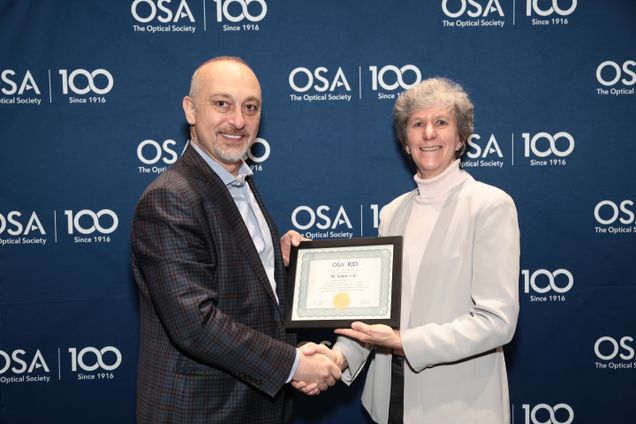Three ENG Professors Elected OSA Fellows
by Liz Sheeley
Professor David Boas (BME, ECE), Professor Selim Ünlü (ECE, MSE), and Associate Professor Luca Dal Negro (ECE, MSE, Physics) have been elected as Fellows of The Optical Society (OSA).

According to the OSA, “Fellows are members who have served with distinction in the advancement of optics and photonics. No more than 10 percent of the total OSA membership may be chosen as Fellows, making the process both highly selective and competitive.”
Boas has pioneered the development of functional near-infrared spectroscopy (fNIRS) and contributed other advances within biomedical optics. fNIRS is a brain imaging technique that does not require the subject to sit completely still for long periods of time. He was recently awarded a National Institutes of Health grant to build a wearable version of fNIRS to facilitate neurological research on mobile subjects.
Boas joined the faculty in 2017 and has quickly established relationships with faculty outside of engineering—his lab is collaborating with researchers in the Sargent College of Health and Rehabilitation Sciences to allow them to study neural activity in stroke patients before, during and after therapy and in Psychological and Brain Sciences to study autism. In addition to funding the development of the mobile and wearable version of fNIRS, the grant will let Boas push out a more advanced version of the companion software with more technical features and lead international workshops on the technology and how to use it. “This is a great opportunity to bring fNIRS to BU, and grow the international community of closely collaborating users and technology developers,” says Boas.
The concept of light interference has been documented since the 1600s, but Ünlü has been able to apply the concept to enhance the light collection efficiency of photodetectors and to develop novel biological sensing and imaging technologies. Light interference can be seen in the colorful reflections created by soap bubbles—the bubble’s film partially reflects back light at its closely-spaced surfaces, preferentially enhancing or decreasing the reflection of colors constituting the white light illumination.
Ünlü uses this concept to detect nanoparticles as the presence of particles modifies the interference of light reflected from the sensor surface, producing a distinct signal that reveals the size of the particle (which is not otherwise visible under a conventional microscope). This technique has allowed Ünlü to quickly and accurately detect viruses in a blood sample. The method doesn’t require the user to be highly skilled or trained, no sample preparation is needed and the instrument does the work making this an ideal technique to transfer to resource-poor areas.
Dal Negro has been elected for his numerous contributions to the optics of complex media that explained how electromagnetic waves interact with structurally disordered nanostructures and nanomaterials. The understanding of how light waves behave in these media allows researchers to engineer novel approaches that control and enhance the intensity of electric fields and increase the efficiency of key technological materials such as silicon at a nanoscale level. Dal Negro can use that knowledge to develop new devices for solid-state lighting such as LEDs, nanolasers, biosensors, and more efficient nanomaterials for solar energy technology.